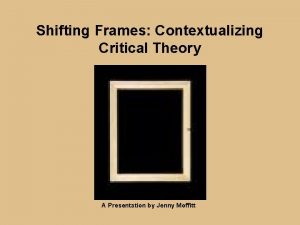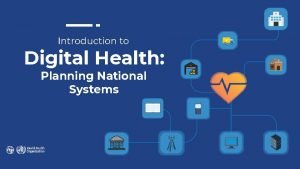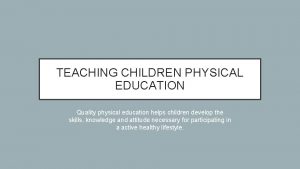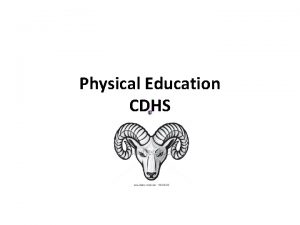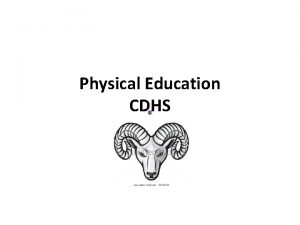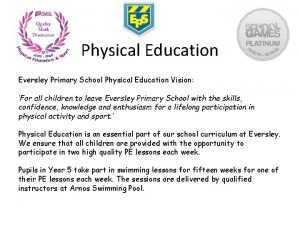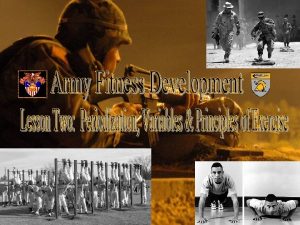Contextualizing teaching and teaching of the Physical Education




















- Slides: 20

Contextualizing teaching and teaching of the Physical Education and Sport in Haiti and Martinique to the first two cycles of the fundamental school and elementary school: comparative analysis of systems of teaching and learning interactions in socio-didactic approach Preslet MEGIE Ph. D student in education sciences Université des Antilles – ÉSPÉ Guadeloupe CRREF (EA 4538)

Introduction ● Derivative of two systems of school education within a single discipline of teaching (PES) through a comparative analysis ● Research work based on the process of contextualization as confrontation between various contexts ● Original work on Haiti and Martinique in order to provide new leads to reflections on regional, national and international

Starting questions ● What is the institutional vision of the PES? ● What are the designs of the PES by the teachers, what are the reported practices of the PES? ● What are the gaps or joints between the curriculum prescribed, declared and real? ● What think students have learned?

Three goals ● Convergent and divergent points in the school forms of PES in Haiti and Martinique ● Effects of the context on the design of curricula and the effects of context on the transmitted knowledge ● Analyse the specificities of didactic interaction in Haiti and Martinique

Research issues ● Identification of the elements of context in teaching of the PES in the first two cycles of the fundamental in Haiti school and elementary school in Martinique ● Description, interpretation and analysis of the educational aims of the two school systems compared to our object of study ● Description, interpretation and analysis of the elements with similarities and likenesses under different aspects (social, cultural, historical, etc)

Theoretical framework Comparative education ↓ Bring out the elements of specificity and genericity of the two school systems in the light of the local context and didactic actions Disciplinary didactic and comparative didactic ↓ comparative didactic of teaching practices of the EPS of two countries: highlighting of didactic intentions and teaching interaction Socio-didactic ↓ crossover look between sociological and didactic ↓ in conjunction with the contextualization (contextualization as interactive relationships between the acting teacher and the context according to Blanchet, 2009)

Research problem Study of the effects of context on the transmitted knowledge and teaching strategies What are the effects of specific contexts ● on the evolution of knowledge in the class and the conditions of their transmission? ● on the teaching strategies

Method Two levels of analysis Macro Micro Comparative analysis of systems of teaching and the organisation of the EPS through official texts ● Haiti: Curriculum for the first two cycles of the fundamental school of 1989 ● Martinique: Soundtrack Special Edition 3 of June 19, 2008 Comparative analysis of didactic interactions ● Sample 49 participants (17 teachers: 4 in Haiti and 13 in Martinique 32 students, 16 per country) 8 schools, 4 from each country chosen in different social environments (favored and disadvantaged) Elements of comparison · Organization of schooling · Reforms educational · Training of teachers · Physical sports and artistic activities proposed · Programs of PES · Number of hours planned for the teaching of the EPS · Objectives of the teaching of PES ● Device 28 interviews before/after lessons with 17 teachers (Equal = 28: 15 in Haiti and 12 in Martinique) 90 filmed lessons, 45 by territory (Equal = 30 classes: 3 lessons per class) 32 interviews with 32 students of 5 th/6 th in Haiti and middle course 1/2 in Martinique

Results Elements of comparison Haiti Martinique Organization of schooling Kindergarten - school fundamental (1 st, 2 nd, and 3 rd cycles) and secondary - first two cycles: 6 classes (1 st, 2 nd, 3 rd, 4 th, 5 th, 6 th year) - no access to education for all children - more private than public schools - education is not free 1 st level: kindergarten and elementary school - 2 nd level: secondary school - elementary school: 5 classes (preparatory course, elementary course level 1, elementary course level 2, middle course level 1 and middle course level 2) - access to education for all children - more public than private schools – education is free Reforms educational Dartigue (1929), Bernard (1979), National education and training plan (1997), Operational plan (2010 -2015) Berthoin (1959), Fouchet (1975), Jospin (1989), Fillon (2005), Peillon (2013) Training of teachers Public and private training centers – Universities – More private than public training centers Public and private training centers – Universities – More public than private training centers Physical sports and artistic activities proposed Physical preparation by the games of awakening, of address, balance and gymnastics - athletic activities - sports and group games with ball Athletic activities - sports and group games with ball - rolling activities and gliding, climbing, orientation - swimming - games of expression, artistic and aesthetic - games of struggle and snowshoes Programs of the PES Curriculum 1 st and 2 nd cycles of the fundamental School of 1989 (not updated since)-renovation considered in the operational Plan 2010 -2015 Soundtrack Special Edition 3 of 19 June 2008 soundtrack special No. 11 of 26 November 2015 Number of hours planned for the teaching of the PES 30 and 1 hours (1 st/2 nd year of fundamental school ) and 60 and 2 hours in (3 rd, 4 th, 5 th, 6 th year of fundamental school) 108 -3 hours in (Preparatory course and elementary course level 1) and (Elementary course level 2 -Middle course level 1 - Middle course level 2) Objectives of the teaching of PES Not mentioned in the Physical education program of the first two cycles of the fundamental school Preparatory course and elementary course level 1: develop capacity to motor lines - offer a 1 st introduction to the physical sports and artistic activities - ensure his health Elementary course level 2 -Middle course level 1 - Middle course level 2: develop motor skills and practice of the APSA - contribute to education to health - education accountability, autonomy and respect of the rules and of oneself and others

Comparison of the main features of the profiles of the 17 teachers in the two territories Profiles Haiti (4 teachers) Martinique (13 teachers) Gender 3 men – 1 woman More men than women 2 men – 11 women More women than men Age From 30 to 40 old years From 30 to 50 old years Training in education: 2 teachers Initial training in PES: 3 teachers Training in education: 5 teachers Initial training in PES: 2 teachers Few trained in education and EPS Professional experience From 7 to 12 years Continuous training in PES: 3 teachers From 6 to 29 years Continuous training in PES: 5 teachers Few continuous training in PES Student project Design of the competition: 3 teachers Dominance of competitive projects Design of the competition: 2 teachers bit of competitive projects Social origin Modest and urban Middle and urban Personal sport practice Experience of sports (high performance Design of a physical upkeep: 8 teachers sports): 3 teachers

Different designs of PES Teachers/Haiti Teachers/Martinique Total 1. Developmental 1 2 3 2. Citizen 4 12 16 3. Cultural 4 8 12

Design of the student Different registers of the student design Points of similarities Points of difference Attitude and behavior of students 1. Lack of attention, concentration and listening Haïti 1 Martinique 11 Total 12 Haïti Martinique Total 2. Motivation et determination 3 5 8 3. Surprising students 4. Students assets 5. Sudents talkers 6. Discipline 7. Unruly and hard-working students 8. Dynamism and game community 9. Adaptation of students to the difficult conditions 10. Creative students 11. Curiosity 12. Breaking the rules of life and comrades 13. Student volunteers and applicants 14. Tiring students Learnining of physical sports and artistic activities 1. Craze for PES courses 2 3 1 1 3 3 5 4 4 13 2. Pleasure to practice all of the physical sports and artistic activities 3. Displeasure to practice some physical sports and artistic activities 4. Implementation of learning and performing the requested tasks 4 3 17 2 1 1 1 0 0 0 0 3 2 1 1 10 3 14 6 2 1 3 5. Commitment and reinvestment in activities 0 2 2 Progression and lacf of progression of students 1. Students in success 2. Progression 3. Students in difficulty 4. Partly progression 5. Lack of progression 4 4 4 2 13 7 5 3 17 11 9 5 0 2

Different roles of the 17 teachers interviewed Role of the teacher Points of similarities Points of difference Total Haiti/Martinique Haiti Martinique 1. Organizational 11 6 6 23 2. Relational 4 1 0 5 3. Disciplinary 2 1 2 5

Different acts of contextualization by territory Acts of contextualization Teachers/Haiti Teachers/Martinique Total 1. Institutional 3 2 5 2. Didactic 1 5 6 3. Cultural 2 1 3

Interviews with thirty-two students Categories Points of similarities Haiti/Martinique Points of difference Haiti Total Martinique Acts of learning and the role of the student 10 8 4 22 Role and effect of PES 6 4 4 14 Role of the teacher according to the student 6 2 1 9

Different actions of 17 teachers related to the filmed lessons


Discussion ● Relationship between the prescribed curriculum and the real curriculum about the level of citizenship ● Discrepancy between declared and actual prescribed curriculum at the level of the number of hours for the teaching of the EPS ● Cultural and material contexts items tracking (see Special Edition No. 3 of 2008 soundtrack, filmed in Haiti lessons) ● Dominant learning reported by students: physical sports and artistic activities, play as a team and listen to ● Dominance of the actions of teachers: definition/mesogenesis

Conclusion/Perspectives ● Haiti: limitation of learning related to material constraints ● Martinique: limitation of learning related to behavioural constraints ● Question the teaching of the EPS in Haiti and Martinique and bring new ways of thinking to current research on the issue of didactic contextualization ● Comparative study: contextualization of the PES in elementary school in the overseas department and hexagonal France

THANK YOU FOR YOUR ATTENTION megiepreslet@yahoo. fr
 Contextualizing in critical reading
Contextualizing in critical reading Critical reading
Critical reading Contextualizing language
Contextualizing language Contextualizing
Contextualizing Difference between health education and physical education
Difference between health education and physical education What is microteaching
What is microteaching Price fences marketing
Price fences marketing Physical fitness test grade 9
Physical fitness test grade 9 Hình ảnh bộ gõ cơ thể búng tay
Hình ảnh bộ gõ cơ thể búng tay Slidetodoc
Slidetodoc Bổ thể
Bổ thể Tỉ lệ cơ thể trẻ em
Tỉ lệ cơ thể trẻ em Voi kéo gỗ như thế nào
Voi kéo gỗ như thế nào Chụp phim tư thế worms-breton
Chụp phim tư thế worms-breton Chúa sống lại
Chúa sống lại Các môn thể thao bắt đầu bằng tiếng nhảy
Các môn thể thao bắt đầu bằng tiếng nhảy Thế nào là hệ số cao nhất
Thế nào là hệ số cao nhất Các châu lục và đại dương trên thế giới
Các châu lục và đại dương trên thế giới Công của trọng lực
Công của trọng lực Trời xanh đây là của chúng ta thể thơ
Trời xanh đây là của chúng ta thể thơ Mật thư anh em như thể tay chân
Mật thư anh em như thể tay chân
